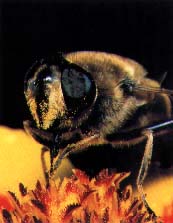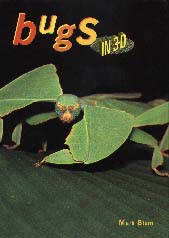|
________________
CM . . . .
Volume VII Number 5 . . . . November 3, 2000
excerpt: When the female spider wasp is ready to breed, she locates a spider, wrestles the spider over, and paralyzes but does not kill it with a sting to the underside. The spider wasp then lays a single egg on its abdomen and buries the spider alive. When the young wasp larva hatches, it drinks the paralyzed spider's fluids.  This book is an eye-catching collection of 44 three-dimensional photographs of bugs and insects.
The photographs are set in the centre of each page, and bound into the front flap of the book is
a sturdy pair of viewing glasses. When held over the page, the lenses are at the optimal distance
for viewing the photographs in three dimensions.
This book is an eye-catching collection of 44 three-dimensional photographs of bugs and insects.
The photographs are set in the centre of each page, and bound into the front flap of the book is
a sturdy pair of viewing glasses. When held over the page, the lenses are at the optimal distance
for viewing the photographs in three dimensions.
The facing pages give information about each photograph, including the common name of the bug and, beneath it, the scientific name, plus an indication of whether the scientific name refers to the class, family, or species to which the bug belongs. Beneath this, a short text explains what the particular insect in the photograph is doing and gives concise information about the insect, sometimes focusing on interesting aspects of body structure, sometimes on behaviour or on how the insect fits in with human society. The paragraphs describing the bugs are both precise and fascinating and include unusual and interesting facts about the insect in the picture. Readers learn, for example, that bumblebees can regulate their own body temperature and that a tarantula's vision is so poor that it can only register changes in light levels. The author explains how grasshoppers calculate distance when they jump and how flies use gyroscopic structures called halteres to provide for stability during flight. The author is very careful to use the correct terminology throughout. Although this approach is laudable, much of the terminology is unfamiliar to a layperson, and the text is so peppered with uncommon words that a younger reader could find it frustrating. The glossary is very well written, but it contains some glaring omissions. Of the categories of biological classification, Phylum, Class, Order, Family, Genus and Species, all are defined except for Family. Important definitions such as Bug, Arachnid and Arthropod are included, but Insect and Beetle are omitted. The text is interesting, but it is the pictures that set this book apart. Arresting, detailed and rendered all the more lifelike by the three-dimensional glasses, the bugs are captured in close-up action - mating, molting, or feeding. The author obviously goes to great lengths to take the pictures, as evidenced by the close-up of a tick on his own forearm! Certainly, there is a gruesome aspect to this subject matter that some readers will find hard to resist. Recommended. Mother of two, Karen Clay is also Head of the William R. Newman Library, Faculty of Agriculture, University of Manitoba.
To comment on this title or this review, send mail to cm@umanitoba.ca.
Copyright © the Manitoba Library Association.
Reproduction for personal use is permitted only if this copyright notice
is maintained. Any other reproduction is prohibited without
permission.
Published by
TABLE OF CONTENTS FOR THIS ISSUE - November 3, 2000.
AUTHORS |
TITLES |
MEDIA REVIEWS |
PROFILES |
BACK ISSUES |
SEARCH |
ORDER |
CMARCHIVE |
HOME
|
